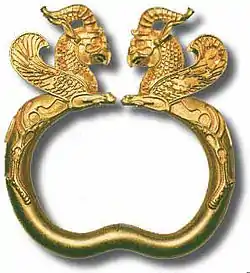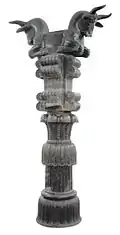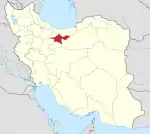موزهٔ ملی ایران Muze-ye Melli-ye Irān | |
 | |
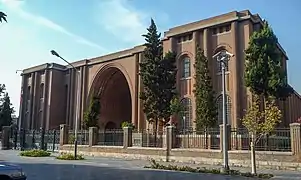 Museum of Ancient Iran | |
| Established | 1937; 86 years |
|---|---|
| Location | Tehran, Iran |
| Type | Archaeology museum |
| Collection size | +3 million |
| Director | Jebrael Nokandeh |
| Owner | ICHTO |
| Website | irannationalmuseum.ir |
The National Museum of Iran (Persian: موزهٔ ملی ایران Mūze-ye Melli-ye Irān) is located in Tehran, Iran. It is an institution formed of two museums; the Museum of Ancient Iran and the Museum of Islamic Archaeology and Art of Iran, which were opened in 1937 and 1972, respectively.
The institution hosts historical monuments dating back through preserved ancient and medieval Iranian antiquities, including pottery vessels, metal objects, textile remains, and some rare books and coins.[1] It also includes a number of research departments, categorized by different historical periods and archaeological topics. National Museum of Iran is the world's most important museum in terms of preservation, display and research of archaeological collections of Iran, and currently displays works that express the richness of culture, civilization, art, economic growth and technological achievements of Iranians.
History
The brick building of the Museum of Ancient Iran was designed by French architects André Godard and Maxime Siroux in the early 20th century, and was influenced by Sassanian vaults, particularly the Taq Kasra at Ctesiphon.[2] Its construction, with an area of about 11,000 square metres (13,000 sq yd), began in 1935 and was completed within two years by Abbas Ali Memar and Morad Tabrizi. It was then officially inaugurated in 1937.[3]
The Museum of the Islamic Era was later built with white travertine on the grassy grounds of the Museum of Ancient Iran. Firouz Bagherzadeh, director of the Iranian Center for Archaeological Research, hold a series of symposiums on Iranian archaeology in this building. It has gone through quite a few hasty interior changes, and was still being remodeled when the 1979 Revolution swept the country.
While the Museum of Ancient Iran always had a clear mandate to show archaeological relics, as well as some rare medieval textiles and rug pieces, the newer complex began to also feature the exquisite Amlash pottery from prehistoric Caspian Sea regions of Iran. This followed some modern works, and the repeated gutting and remodeling of the interior.
The Museum of Ancient Iran consists of two floors. Its halls contain artifacts and fossils from the Lower, Middle, and Upper Paleolithic, as well as the Neolithic, Chalcolithic, early and late Bronze Age, and Iron Ages I-III, through the Median, Achaemenid, Seleucid, Parthian, and Sassanian eras.
The newer complex consists of three floors. It contains various pieces of pottery, textiles, texts, artworks, astrolabes, and adobe calligraphy, from Iran's post-classical era.
Museum of Ancient Iran
.jpg.webp)
The permanent exhibition covers a surface area of some 4,800 square meters on two floors and a basement, containing selected artifacts in chronological order, from the Lower Paleolithic period (ca. 1,000,000 years ago) to the end of Sasanian times (651 CE). The first-floor galleries contain prehistoric objects including Paleolithic, Epipaleolithic, Neolithic, and Chalcolithic artifacts. The ground floor galleries contain historic objects including Bronze Age, Elamite, Iron Age, Median, Achaemenid, Seleucid, Parthian, and Sassanian artifacts.
The oldest artifacts kept at the museum are from Kashafrud, Darband, and Shiwatoo, which date back to the Lower Paleolithic period. Mousterian stone tools made by Neanderthals are also on display at the first hall of the Museum of Ancient Iran. The most important Upper Paleolithic tools are from Yafteh, dating back about 30,000 to 35,000 years. The Paleolithic personal ornaments, clay, and human figurines from the early village communities such as 9,000-year-old human and animal figurines from Sarab mound in Kermanshah, the earliest evidence of administrative technology and writing from the 4th millennium BC, Persepolis stone reliefs and capitals, Parthian life-size bronze statue of the "Shami Man", the natural mummy of a man called "Saltmen", are among the important objects in the museum.
Islamic Archaeology and Art of Iran

The Museum of Islamic Archaeology and Art of Iran covers some 4000 square meters with three floors is a part of the National Museum of Iran. Its octagonal plan is inspired by the Sasanid palace at Bishāpur. The museum building was designed by architect Eugene Aftandilian, and its construction began in the 1940s and was completed in the 1950s. The building was initially used as an ethnography museum and for temporary exhibitions. After a period of renovation, the building was reopened in 1996 as the Museum of the Islamic Era. In the summer of 2006, another phase of restoration and reconstruction began, and the new museum was reopened in 2015. The ground floor is designated as the auditorium and the temporary exhibitions hall. The Islamic artifacts are on display chronologically on the first and second floors. The second floor contains the early Islamic, Seljuq, and Ilkhanid periods and the first floor houses the holy Qurān hall, and artifacts of the Timurid, Safavid, Afshār, Zand and Qajar periods.
Exhibitions
The ground floor of the newer complex has been dedicated to contemporary exhibitions. Temporary exhibition galleries are featured two or three times annually and usually run for about one to two months. One of the most successful exhibitions, entitled Evidence for Two Hundred Thousand Years of Human-Animal Bonds in Iran, ran from August to October 2014.[4] The exhibition was mainly about the relation and coexistence of past human societies and various animal species in Iran, since the late Lower Paleolithic to modern decades.
Departments
| Department | Head |
|---|---|
| Research Group | Yousef Hassanzadeh |
| Paleolithic Department | Fereidoun Biglari |
| Prehistoric Department | Fariba Moejezati |
| Historic Department | Shahram Heidarabadian |
| Islamic Department | Karam Mirzaei |
| Coins and seals Department | Fereshteh Zokaei |
| Inscriptions Department | Sedigheh Piran |
| Conservation Department | Parvaneh Soltani |
| Pottery Department | Omolbanin Ghafoori |
| Osteological Department | Marjan Mashkour |
| Library and archive | Azam Jaloli |
| Exhibitions Department | Nina Rezaei |
| Technical Building Department | Majid Moradi |
| Photographic Studio | Mahbobeh Ghelich Khani |
| Public affairs | Hassan Moradi |
| Legal and International relations | Masoumeh Ahmadi |
Management
| Name | Education/Activities |
|---|---|
| Andre Godard
(1939-?) |
French architect, archaeologist and researcher. Head of the department of Antiquities and Museum of Ancient Iran and the founder of the National Museum of Iran. The designer of: National Library building, the tomb of Hafez, the tomb of Ferdowsi and the tomb of Saadi. The founder of the faculty of Fine Arts in the University of Tehran, and the first manager of this faculty. |
| Suleiman Sepahbodi
(1949-?) |
A archaeologist and one of the members of the Association of Education and Inspection of Antiquities Department. |
| Mehdi Bahrami
(1949-1951) |
PhD degree in archaeology from United States. Activities in the Islamic section of the Berlin Museum, compilations such as Iranian industries and pottery, Gorgan pottery, etc. |
| Mohammad Thaqi Mostavafi
(1951-1955) |
Legal archaeologist, specialist in Achaemenid and Seljuk archaeology. Head of the General Directorate of Archaeology, Head of the Ancient Iran Museum, Head of the National Antiquities Association; publications on the history archaeological culture in Iran. |
| Ali Hakemi
(1955-1966) |
PhD in archaeology. Activities in the historical department of Ancient Iran Museum, exploration committees, publication of the "Shahdad explorations" book which was also published in Italy. Setting up several museums such as Pars Museum in Shiraz and Chehelston Museum in Isfahan. |
| Ezatolah Negahban
(1966-1973) |
PhD in Archeology from the University of Pennsylvania. Rescuing historical sites, establishing the Institute of Archeology at Tehran University, being in the General Department of Archaeology, founding the first independent Iranian excavations in Marlik and Haft Tepe, transforming the educational structure of this field and publishing books at world levels. |
| Abdol-Hossein Shahidzadeh
(1973-1975) |
Studied archeology and art history, graduated from the University of Tehran. Exploring the Sassanid sites of Sondos and the Parthian site in Rostamabad etc. |
| Firuz Bagherzadeh
(1975-1976) |
PhD in archeology and history of Islamic art in France. The first chairman of the UNESCO World Heritage Committee in 1977, proposed the world registration of Persepolis, Chogha Zanbil and Naqsh Jahan Square. |
| Mohammad-Yousuf Kiani
(1976-1978) |
PhD in archeology and art history of the Islamic period from the University of London. Exploration in Gorgan plains, head of Iranian museums, teaching as an assistant professor in the archeology department of Tehran University, publication of more than 30 books in the field of archeology and architectural art and articles in domestic and international forums. |
| Seifollah Khambaghshfard
(1979-1981) |
Archaeologist, researcher and author. Organization and liberation of the Kangavar archaeological collection, member of the prehistoric department of the Museum of Ancient Iran and responsible for the archive of this museum, assistant to Ezatollah Gardhani in the department of the Institute of Archeology of Tehran University, expert in charge of archeology in the Center of Archeology of Iran, activity in the excavations of Marlik, Chirag Ali Tepe in Gilan and etc. |
| Nosratollah Mootamedi
(1981-1982) |
Archaeologist. He was sentenced to pay a fine for the crime of destroying national and historical property and went to prison. |
| Qholamreza Maasomi
(1982-1987) |
PhD in archaeology. Head of the Iranian Archeology Center, publishing books such as Siraf or Bandar Taheri, History of Archeology, etc. |
| Jalil Golshan Bafghi
(1987-1995) |
Master's student in archeology and art history from Tehran University. Research deputy of cultural heritage organization, organizing and reopening parts of the museum that were closed or under renovation. Following up on the case of registering Iranian works in the World Heritage List. |
| Ahmad Tehrani Moghadam
(1995-?) |
Studied archeology from Tehran University. Preparing the ground for the construction and operation of the Museum of Islamic Archaeology and Art of Iran, working in the Iranian Archeology Center, supervising the exploration teams. |
| Mohammad-Reza Kargar
(?-2007) |
Studied archeology at Tehran University. Launching international exhibitions in the world's major museums, signing contracts with the world's major museums. |
| Mohammad-Reza Mehrandish
(2007-2009) |
Bachelor of Literature graduate. Compilation of the draft of the comprehensive plan of the National Museum of Iran, Director of Public Relations of the Cultural Heritage Organization. |
| Azadeh Ardakani
(2009-2011) |
Bachelor of Microbiology. The efforts made by the previous managers for the world registration of the tomb of Sheikh Safiuddin and Tabriz bazaar were completed in this period, the international secretary of the Arya heritage website, the editor of the Parse newspaper. |
| Darius Akbarzadeh
(2011-2015) |
PhD in culture and ancient languages. |
| Jebrael Nokandeh
(Since 2015) |
PhD in archeology from the Institute of Near Eastern Archeology (Berlin). Opening the section related to the prehistoric period, completing the restoration operation of the Museum of Islamic Arts after 9 years, integrating the data of different sections, organizing storage areas and producing different catalogs of the museum's important collections, and holding joint programs between the National Museum of Iran and the largest museums around the world such as Louvre, Museum Island etc. |
Gallery
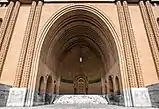 Museum of Ancient Iran, part of the National Museum of Iran.
Museum of Ancient Iran, part of the National Museum of Iran.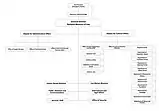 Organizational chart of National Museum of Iran
Organizational chart of National Museum of Iran The entrance of the Museum of Ancient Iran, part of the National Museum of Iran.
The entrance of the Museum of Ancient Iran, part of the National Museum of Iran.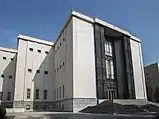 Museum of the Islamic Era, part of the National Museum of Iran.
Museum of the Islamic Era, part of the National Museum of Iran.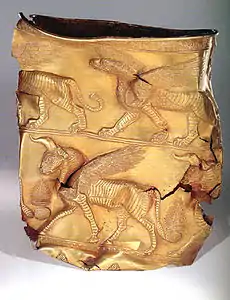 An Iron-Age gold cup from Marlik, kept at the Museum of Ancient Iran.
An Iron-Age gold cup from Marlik, kept at the Museum of Ancient Iran.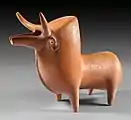 An Iron-Age animal statue from Marlik, kept at the Museum of Ancient Iran.
An Iron-Age animal statue from Marlik, kept at the Museum of Ancient Iran.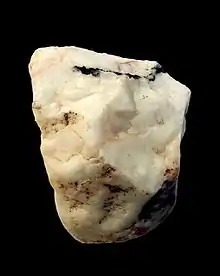 A chopper from the Lower Paleolithic, found at Kashafrud, kept at the Museum of Ancient Iran.
A chopper from the Lower Paleolithic, found at Kashafrud, kept at the Museum of Ancient Iran._Amar_Merdeg%252C_Mehran%252C_Ilam%252C_Lower_Paleolithic%252C_National_Museum_of_Iran.jpg.webp) A trihedral from the Lower Paleolithic, found at Amar Merdeg, kept at the Museum of Ancient Iran.
A trihedral from the Lower Paleolithic, found at Amar Merdeg, kept at the Museum of Ancient Iran.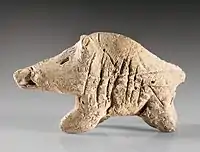 A clay boar figurine from the Neolithic period, found at Tepe Sarab, kept at the Museum of Ancient Iran.
A clay boar figurine from the Neolithic period, found at Tepe Sarab, kept at the Museum of Ancient Iran..jpg.webp) The Saltmen, kept at the Museum of Ancient Iran.
The Saltmen, kept at the Museum of Ancient Iran._Tappeh_Sarab%252C_Kermanshah_ca._7000-6100_BCE_Neolithic_period%252C_National_Museum_of_Iran.jpg.webp) A clay figurine of a fertility goddess found at Tepe Sarab, dating back to the Neolithic, kept at the Museum of Ancient Iran.
A clay figurine of a fertility goddess found at Tepe Sarab, dating back to the Neolithic, kept at the Museum of Ancient Iran. A chlorite object with the Master of Animals motif from Kerman's Jiroft culture, dating back to Bronze Age I, kept at the Museum of Ancient Iran.
A chlorite object with the Master of Animals motif from Kerman's Jiroft culture, dating back to Bronze Age I, kept at the Museum of Ancient Iran.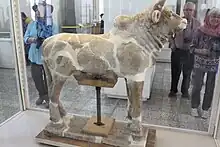 An Elamite bull statue, kept at the Museum of Ancient Iran.
An Elamite bull statue, kept at the Museum of Ancient Iran..JPG.webp)
.JPG.webp) The statue of a Parthian nobleman, kept at the Museum of Ancient Iran.
The statue of a Parthian nobleman, kept at the Museum of Ancient Iran.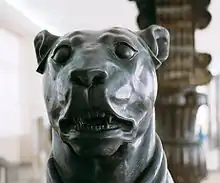 A Persepolitan mastiff statue, kept at the Museum of Ancient Iran.
A Persepolitan mastiff statue, kept at the Museum of Ancient Iran..JPG.webp) The statue of Darius the Great, kept at the Museum of Ancient Iran.
The statue of Darius the Great, kept at the Museum of Ancient Iran. A statue of a Sasanian nobleman from Hajjiabad, Fars, kept at the Museum of Ancient Iran.
A statue of a Sasanian nobleman from Hajjiabad, Fars, kept at the Museum of Ancient Iran.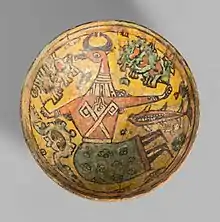 A 9th-century ceramic bowl from Gorgan, decorated with slip beneath a transparent glaze, designing an anthropic figure with bull head, kept at the Museum of the Islamic Era.
A 9th-century ceramic bowl from Gorgan, decorated with slip beneath a transparent glaze, designing an anthropic figure with bull head, kept at the Museum of the Islamic Era. A 19th-century hookah, kept at the Museum of the Islamic Era.
A 19th-century hookah, kept at the Museum of the Islamic Era._18th_century_CE%252C_Qajar_period%252C_National_Museum_of_Iran.jpg.webp) An 18th-century watercolor painting signed by Abol-Hasan Qaffari (Sani-ol-Molk), from the Qajar period, kept at the Museum of the Islamic Era.
An 18th-century watercolor painting signed by Abol-Hasan Qaffari (Sani-ol-Molk), from the Qajar period, kept at the Museum of the Islamic Era.
See also
References
- ↑ "Otraq.com, Iran's Tourism Guide" Archived 2014-10-20 at the Wayback Machine
- ↑ Sandy Isenstadt, Kishwar Rizvi. Modernism and the Middle East: Architecture and Politics in the Twentieth Century. Studies in Modernity and National Identity. University of Washington Press, 2011. ISBN 0295800305 pp.14
- ↑ Nokandeh, Jebrael (ed.) 2019. A Survey of the History of Iran on the Basis of Iran National Museum Collections, Second edition, Iran National Museum with the contribution of Baloot Noghrei Institute, Tehran
- ↑ "The Guardian's report about exhibition"
External links
- Official website of Iran National Museum
- Official website of Journal of Iran National Museum
- Photo Gallery of the National Museum of Iran
- Virtual Tour of Iran National Museum 1
- Virtual Tour of Iran National Museum 2

